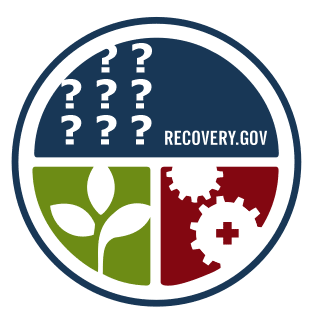 Recovery.gov is the tip of the spear for the Obama administration’s stimulus transparency plan. The site is intended as a one-stop shop, with comprehensive weekly reports on stimulus progress from federal agencies. As the director of the president’s Office of Management and Budget wrote, the site’s purpose is to allow “citizens to hold the government accountable for every dollar spent.”
Recovery.gov is the tip of the spear for the Obama administration’s stimulus transparency plan. The site is intended as a one-stop shop, with comprehensive weekly reports on stimulus progress from federal agencies. As the director of the president’s Office of Management and Budget wrote, the site’s purpose is to allow “citizens to hold the government accountable for every dollar spent.”
But, after three weeks of reporting, the numbers reveal bleak generalities - stimulus money flowing at a trickle – and few details to clarify the data or overcome the layman’s obstacles to interpreting it. Our chart of spending by agency appears below.
The chart lists, by department or agency, the total amount of money appropriated to the agencies by Congress, the amount obligated – bureaucrat-ese for an agency’s commitment (by signing a contract or placing an order, for example) to make payments – and disbursements, the amount actually spent on the projects.
$6.5 billion -- a touch under two percent of the $364 billion that has already been appropriated to the agencies -- has made it into the economy as of March 20, the last date reports were filed. Another five percent ($18.49 billion) is obligated. Most of the money already spent went to the states to cover Medicaid expenses.
Critics and officials responsible for the program both expect spending, and transparency measures, to improve with time. At this early stage, the reports lay out the appropriations provisions from the stimulus bill, which we already knew about, and keep viewers abreast of how much of that money has been either obligated or paid out on a weekly basis. (Here’s a sample.) The reports cover a one week period ending on a Friday, and OMB requires agencies to submit them by the following Tuesday.
What the reports won’t tell you is how the money is spent, exactly who’s receiving it or whether it was spent appropriately. Also, the spreadsheets are pocked with irregularities of formatting and language that alarm even experienced data diggers.
“It’s a great, noble intention,” said Bill Allison, a senior fellow at the Sunlight Foundation, a government accountability program, who described Recovery.gov as an iterative project and said he was optimistic. “But right now, it’s not a site that you can do a lot with.”
Allison suggested plain language and more complete descriptions as starting points for improvements: “There could be a lot more done to make these accessible to the average person who comes to the site.”
Some departments have chosen to use unfamiliar acronyms instead of plain English to describe their programs. The Department of Commerce, for example, notes $650 million that has been appropriated for “NTIA DTACBP (it’s on the sample).” That translates as the National Telecommunications and Information Agency’s Digital-to-Analog Converter Box Program, or stimulus for TV rabbit ears.
In addition, the reports use arcane “treasury codes,” designating agencies and accounts by number instead of name, for no clear reason (Here’s the decoder).
The site also has a complicated definition of spending. The difference between obligations and disbursements could be as simple as signing a check. An obligation, explained Tom Gavin, an OMB spokesman, is a “definite commitment” that means the government is required by law to pay for something.
“An agency incurs an obligation, for example, when it places an order, signs a contract, awards a grant, purchases a service, or takes other actions that require the government to make payments,” Gavin continued in an e-mail response to ProPublica’s questions.
By contrast, a disbursement is a federal agency’s payment “to liquidate government obligations.” In other words, cash or checks change hands. There’s not a glossary on Recovery.gov explaining these distinctions.
We asked Gavin and other officials whether plans were in place to clarify the reports or to help agencies hasten spending, but we haven’t heard back yet. We’ll keep you updated.
| Department/Agency | Appropriated | Obligated | Spent |
|---|---|---|---|
| Total | 363,992,263,995 | 25,064,210,288 | 6,570,391,008 |
| Corp. for National and Community Service | 201,000,000 | 0 | 0 |
| Agriculture | 28,025,940,000 | 417,172,576 | 19,647,139 |
| Commerce | 7,936,000,000 | 126,492,504 | 1,235,263 |
| Defense | 7,435,000,000 | 0 | 0 |
| Education | 97,407,000,000 | 0 | 0 |
| Energy | 45,225,000,000 | 10,000 | 0 |
| Health and Human Services | 43,833,598,242 | 15,756,530,856 | 6,545,415,831 |
| Homeland Security | 2,755,000,000 | 2,325,000 | 0 |
| Housing and Urban Development | 13,625,000,000 | 4,234,921,738 | 0 |
| Justice | 4,002,000,000 | 0 | 0 |
| Labor | 23,240,018,753 | 18,753 | 0 |
| State | 563,650,000 | 0 | 0 |
| Interior | 2,990,000,000 | 0 | 0 |
| Transportation | 48,120,000,000 | 3,720,590,759 | 1,632,082 |
| Treasury | 318,000,000 | 0 | 0 |
| Veterans Affairs | 1,408,200,000 | 0 | 0 |
| Environmental Protection Agency | 7,179,250,000 | 9,718 | 0 |
| Federal Communications Commission | 0 | 0 | 0 |
| General Services Administration | 5,857,000,000 | 0 | 0 |
| NASA | 1,002,000,000 | 0 | 0 |
| National Endowment for the Arts | 50,000,000 | 1,125 | 0 |
| National Science Foundation | 3,002,000,000 | 0 | 0 |
| Railroad Retirement Board | 21,480,000 | 0 | 0 |
| Small Business Administration | 730,000,000 | 803,059,523 | 0 |
| Smithsonian Institution | 25,000,000 | 0 | 0 |
| Social Security Administration | 14,440,127,000 | 3,077,736 | 2,460,693 |
| Defense, Civil (Army Corps) | 4,600,000,000 | 0 | 0 |



